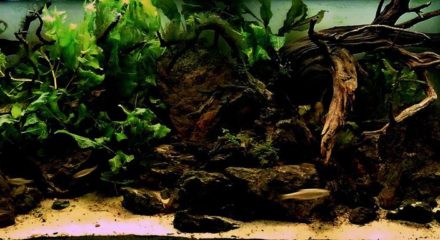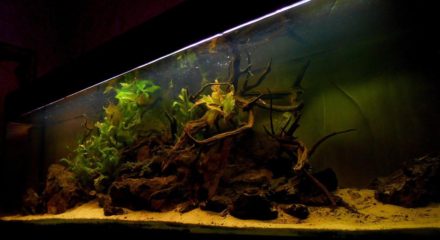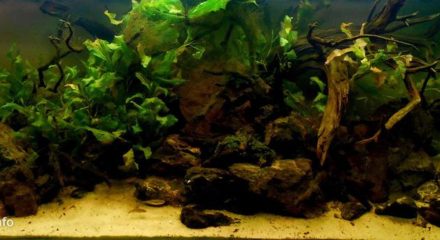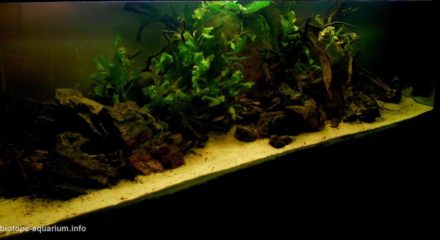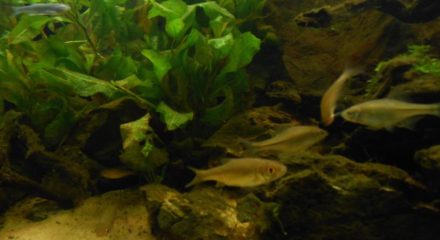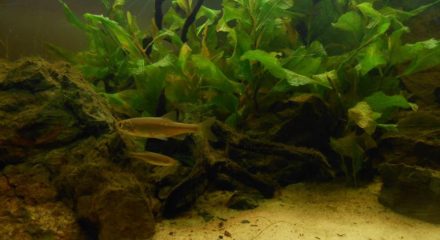Miusik River in the Luhansk region of Ukraine
29th place in Biotope Aquarium Design Contest 2016
![]() Ukraine. Oleg Sychov
Ukraine. Oleg Sychov
Aquarium Volume: 300 L
Fish and invertebrates: Leucaspius delineatus
Plants list: Potamogeton lucens
Biotope description: The inspiration was a trip to the river, to the location where stones are. Majestic fossilized giants standing over the water, reflecting in it already millions of years. Miusik River flows through Luhansk region of Ukraine. This is mainly flat terrain, but sometimes there is a very interesting stones, in combination with water they create an inspiring scenery. Significant distance from large cities affected the quality of water and the whole ecosystem. Large diversity of flora and fauna is striking in its beauty. In the aquarium a species of pondweed was used. Pondweed play a huge role in the ecology of inland waters: these plants and their seeds serve as food for many aquatic and semi-aquatic animals, they give shelter to fish and aquatic invertebrates, their leaves and stems are a place for many species of aquatic organisms to breed. Pondweed is water quality indicator. Thus, the Berchtold pondweed indicates a very strong water pollution. There are algae also here. Thread algae thrive. Leucaspius delineatus is not large but interesting fish. Habitats of Leucaspius delineatus are small slow-moving rivers, lakes, reservoirs floodplain oxbow type of artificial ponds, quarries, with sandy, slightly silted bottom. In summer it keeps in warm surface water layers, active day and night, in autumn it goes in depth. In spring and autumn Leucaspius delineatus keeps near the bottom, and in the winter burrows in the ground. Also in the river there are perch, pike, rudd and crucian carp. In the river also there are Ceratophyllum with different types of pondweed, such as Potamogeton crispus, creating large thickets along the coastline. This habitat shows that not only the tropical aquatic life may be of interest, but also our local plants and fish look and feel good in aquarium. Of course pronounced seasons in our region affect the lifestyle. In winter, many plants die.
Fish and invertebrates: Leucaspius delineatus
Plants list: Potamogeton lucens
Biotope description: The inspiration was a trip to the river, to the location where stones are. Majestic fossilized giants standing over the water, reflecting in it already millions of years. Miusik River flows through Luhansk region of Ukraine. This is mainly flat terrain, but sometimes there is a very interesting stones, in combination with water they create an inspiring scenery. Significant distance from large cities affected the quality of water and the whole ecosystem. Large diversity of flora and fauna is striking in its beauty. In the aquarium a species of pondweed was used. Pondweed play a huge role in the ecology of inland waters: these plants and their seeds serve as food for many aquatic and semi-aquatic animals, they give shelter to fish and aquatic invertebrates, their leaves and stems are a place for many species of aquatic organisms to breed. Pondweed is water quality indicator. Thus, the Berchtold pondweed indicates a very strong water pollution. There are algae also here. Thread algae thrive. Leucaspius delineatus is not large but interesting fish. Habitats of Leucaspius delineatus are small slow-moving rivers, lakes, reservoirs floodplain oxbow type of artificial ponds, quarries, with sandy, slightly silted bottom. In summer it keeps in warm surface water layers, active day and night, in autumn it goes in depth. In spring and autumn Leucaspius delineatus keeps near the bottom, and in the winter burrows in the ground. Also in the river there are perch, pike, rudd and crucian carp. In the river also there are Ceratophyllum with different types of pondweed, such as Potamogeton crispus, creating large thickets along the coastline. This habitat shows that not only the tropical aquatic life may be of interest, but also our local plants and fish look and feel good in aquarium. Of course pronounced seasons in our region affect the lifestyle. In winter, many plants die.

